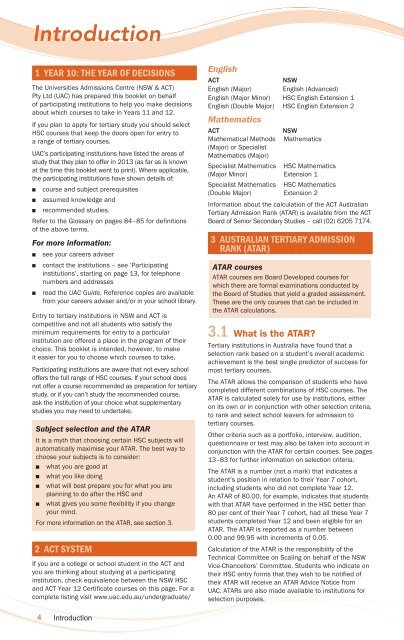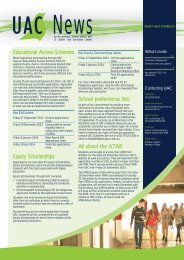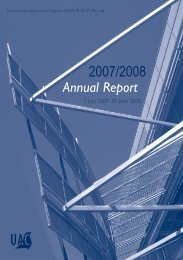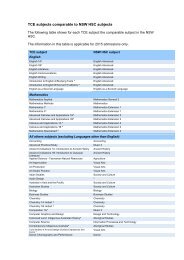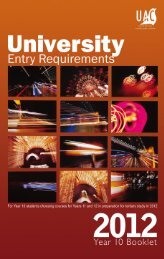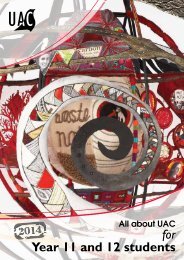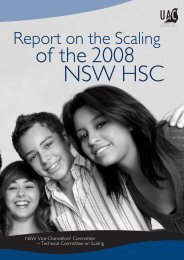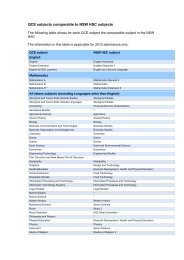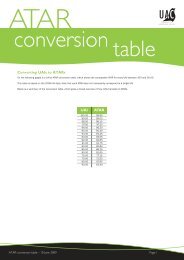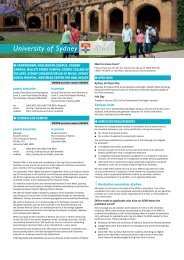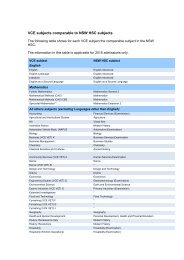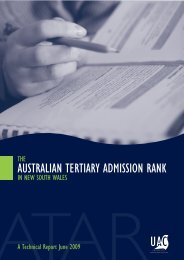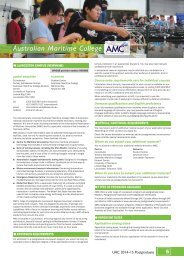Introduction1 YEAR <strong>10</strong>: THE YEAR OF DECISIONSThe <strong>Universities</strong> Admissions Centre (NSW & ACT)Pty Ltd (UAC) has prepared this booklet on behalfof participating institutions to help you make decisionsabout which courses to take in <strong>Year</strong>s 11 and 12.If you plan to apply for tertiary study you should selectHSC courses that keep the doors open for entry toa range of tertiary courses.UAC’s participating institutions have listed the areas ofstudy that they plan to offer in 2013 (as far as is knownat the time this booklet went to print). Where applicable,the participating institutions have shown details of:n course and subject prerequisitesn assumed knowledge andn recommended studies.Refer to the Glossary on pages 84–85 for definitionsof the above terms.For more information:n see your careers advisern contact the institutions – see ‘Participatinginstitutions’, starting on page 13, for telephonenumbers and addressesn read the UAC Guide. Reference copies are availablefrom your careers adviser and/or in your school library.<strong>Entry</strong> to tertiary institutions in NSW and ACT iscompetitive and not all students who satisfy theminimum <strong>requirements</strong> for entry to a particularinstitution are offered a place in the program of theirchoice. This booklet is intended, however, to makeit easier for you to choose which courses to take.Participating institutions are aware that not every schooloffers the full range of HSC courses. If your school doesnot offer a course recommended as preparation for tertiarystudy, or if you can’t study the recommended course,ask the institution of your choice what supplementarystudies you may need to undertake.Subject selection and the ATARIt is a myth that choosing certain HSC subjects willautomatically maximise your ATAR. The best way tochoose your subjects is to consider:n what you are good atn what you like doingn what will best prepare you for what you areplanning to do after the HSC andn what gives you some flexibility if you changeyour mind.For more information on the ATAR, see section 3.2 ACT SYSTEMIf you are a college or school student in the ACT andyou are thinking about studying at a participatinginstitution, check equivalence between the NSW HSCand ACT <strong>Year</strong> 12 Certificate courses on this page. For acomplete listing visit www.uac.edu.au/undergraduate/EnglishACTNSWEnglish (Major) English (Advanced)English (Major Minor) HSC English Extension 1English (Double Major) HSC English Extension 2MathematicsACTNSWMathematical Methods Mathematics(Major) or SpecialistMathematics (Major)Specialist Mathematics HSC Mathematics(Major Minor) Extension 1Specialist Mathematics HSC Mathematics(Double Major) Extension 2Information about the calculation of the ACT AustralianTertiary Admission Rank (ATAR) is available from the ACTBoard of Senior Secondary Studies – call (02) 6205 7174.3 AUSTRALIAN TERTIARY ADMISSIONRANK (ATAR)ATAR coursesATAR courses are Board Developed courses forwhich there are formal examinations conducted bythe Board of Studies that yield a graded assessment.These are the only courses that can be included inthe ATAR calculations.3.1 What is the ATAR?Tertiary institutions in Australia have found that aselection rank based on a student’s overall academicachievement is the best single predictor of success formost tertiary courses.The ATAR allows the comparison of students who havecompleted different combinations of HSC courses. TheATAR is calculated solely for use by institutions, eitheron its own or in conjunction with other selection criteria,to rank and select school leavers for admission totertiary courses.Other criteria such as a portfolio, interview, audition,questionnaire or test may also be taken into account inconjunction with the ATAR for certain courses. See pages13–83 for further information on selection criteria.The ATAR is a number (not a mark) that indicates astudent’s position in relation to their <strong>Year</strong> 7 cohort,including students who did not complete <strong>Year</strong> 12.An ATAR of 80.00, for example, indicates that studentswith that ATAR have performed in the HSC better than80 per cent of their <strong>Year</strong> 7 cohort, had all these <strong>Year</strong> 7students completed <strong>Year</strong> 12 and been eligible for anATAR. The ATAR is reported as a number between0.00 and 99.95 with increments of 0.05.Calculation of the ATAR is the responsibility of theTechnical Committee on Scaling on behalf of the NSWVice-Chancellors’ Committee. Students who indicate ontheir HSC entry forms that they wish to be notified oftheir ATAR will receive an ATAR Advice Notice fromUAC. ATARs are also made available to institutions forselection purposes.4Introduction
3.2 The ATAR NoticeWhile ATARs are calculated for all ATAR-eligiblestudents, only students who indicate on their HSC entryforms that they wish to be notified of their ATAR receivean ATAR Advice Notice from UAC. These students willreceive their written Advice Notices at the same time asthey receive their HSC results from the Board of Studies.The ATAR Advice Notice includes:n a student’s ATARn a list of the ATAR courses which the student studiedand the categorisation of each course andn the number of units of each ATAR course thatcontributed to the calculation of the ATAR.There are two cases where an ATAR will not be shown onthe ATAR Advice Notice. The first is when a student receivesan ATAR between 0.00 and 30.00, in which case the ATARwill be indicated as "30 or less". The second is when thestudent has not met the <strong>requirements</strong> for an ATAR, in whichcase the statement "Not Eligible" will appear.3.3 Who is eligible for an ATAR?Categorisation of ATAR coursesThere are many HSC courses but not all will contributeto an ATAR. Courses that do contribute to the ATAR areBoard Developed courses for which there are formalexaminations that yield graded assessments. These aretermed ATAR courses.ATAR courses are classified as either Category A orCategory B courses. The criteria for Category A coursesare academic rigour, depth of knowledge, the degree towhich the course contributes to assumed knowledge fortertiary studies, and the coherence with other coursesincluded in the ATAR calculations. Category B coursesare those whose level of cognitive and performancedemands are not regarded as satisfactory in themselves,though their contribution to a selection index is regardedas adequate if the other courses included in theaggregate are more academically demanding.Courses to be examined in 2013 and their categoriesare listed in Table 1 on pages <strong>10</strong>–12. At present thereare few Category B courses.Eligibility for an ATARTo be eligible for an ATAR a student must satisfactorilycomplete at least <strong>10</strong> units of ATAR courses. These ATARcourses must include at least:n eight units from Category A courses andn two units of English andn three Board Developed courses of two unitsor greater andn four subjects.See Table 1 on page <strong>10</strong> for the definition of ‘course’and ‘subject’.You must check your program of study carefully to makesure that you will be eligible for an ATAR.Satisfactorily completed coursesA student will be considered to have satisfactorilycompleted a course if, in the principal’s view, there issufficient evidence that the student has:1 followed the course developed or endorsed by theBoard of Studies, and2 applied themselves with diligence and sustainedeffort to the set tasks and experiences provided inthe course by the school, and3 achieved some or all of the course outcomes, and4 completed at least 50 per cent of the HSC assessmenttasks mandated by their school in that course.Failure to satisfactorily complete a course will result inthat course not contributing to the eligibility <strong>requirements</strong>.If the course is a 2-unit course for which there is anassociated extension course, failure to satisfactorilycomplete the 2-unit course will result in neither the 2-unitnor the extension course contributing towards their ATAR.3.4 Calculation of the ATARThe ATAR is a rank based on an aggregate of scaledmarks in <strong>10</strong> units of ATAR courses. A student’saggregate is based on their:n best two units of English andn best eight units from their remaining units, which caninclude up to two units of Category B courses.Although eligibility for an ATAR requires completion of atleast four subjects, the aggregate may be based on lessthan four subjects, for example English Advanced, EnglishExtension 1 and Extension 2, Mathematics Extension 1and Extension 2, and one other 2-unit course.Marks to be included in the ATAR calculations can beaccumulated over a five-year period but if a course isrepeated, only the last satisfactory attempt is used inthe calculation of the ATAR.Scaled marks are calculated the year the courses arecompleted.Bonus points and cut-offsThe cut-off for a course indicates the minimum rankrequired for selection into the course for most <strong>Year</strong> 12applicants. Some applicants may receive an offer eventhough they have an ATAR below the published cut-off.Often this is because those applicants have beenawarded bonus points by a particular institution. Bonuspoints are allocated for things like strong performancein HSC subjects, living or attending school in a certainarea, and applying for consideration throughEducational Access Schemes. Bonus points are notadded to your ATAR. Bonus points don’t change yourATAR; bonus points change your selection rank for aparticular preference. For most <strong>Year</strong> 12 applicants,their selection rank is their ATAR. But if you have beenawarded bonus points for a particular preference, yourselection rank = your ATAR + bonus points. Therefore,the cut-off includes bonus points where applicable.3.5 How is the ATAR determined?The ATAR is determined by:n scaling the raw HSC marks (which are the average ofthe raw HSC examination marks and the moderatedschool assessments) provided by the Board of Studiesn calculating an aggregate of scaled marks for eachATAR-eligible studentn ranking ATAR-eligible students based on thisaggregate of scaled marksn determining rankings based on what the rankingswould have been if all students in the <strong>Year</strong> 7 cohorthad completed <strong>Year</strong> 12 and been eligible for an ATAR.This ranking is expressed as a percentile truncatedto the nearest 0.05. This is the ATAR.Introduction5


